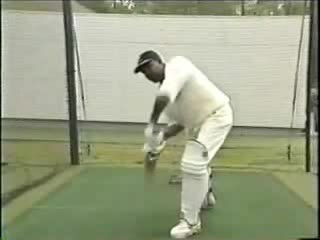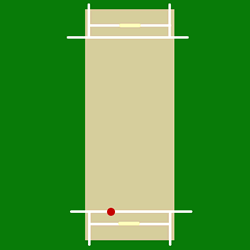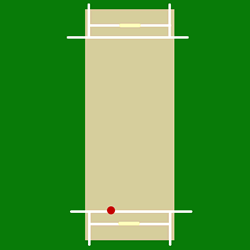This article does not cite any sources .(December 2009) (Learn how and when to remove this template message) |
Off theory is a bowling tactic in the sport of cricket. The term off theory is somewhat archaic and seldom used any more, but the basic tactic still plays a part in modern cricket.

Bowling, in cricket, is the action of propelling the ball toward the wicket defended by a batsman. A player skilled at bowling is called a bowler; a bowler who is also a competent batsman is known as an all-rounder. Bowling the ball is distinguished from throwing the ball by a strictly specified biomechanical definition, which restricts the angle of extension of the elbow. A single act of bowling the ball towards the batsman is called a ball or a delivery. Bowlers bowl deliveries in sets of six, called an over. Once a bowler has bowled an over, a teammate will bowl an over from the other end of the pitch. The Laws of Cricket govern how a ball must be bowled. If a ball is bowled illegally, an umpire will rule it a no-ball. If a ball is bowled too wide of the striker for the batsman to be able to play at it with a proper cricket shot, the bowler's end umpire will rule it a wide.

Sport includes all forms of competitive physical activity or games which, through casual or organised participation, aim to use, maintain or improve physical ability and skills while providing enjoyment to participants, and in some cases, entertainment for spectators. Hundreds of sports exist, from those between single contestants, through to those with hundreds of simultaneous participants, either in teams or competing as individuals. In certain sports such as racing, many contestants may compete, simultaneously or consecutively, with one winner; in others, the contest is between two sides, each attempting to exceed the other. Some sports allow a "tie" or "draw", in which there is no single winner; others provide tie-breaking methods to ensure one winner and one loser. A number of contests may be arranged in a tournament producing a champion. Many sports leagues make an annual champion by arranging games in a regular sports season, followed in some cases by playoffs.
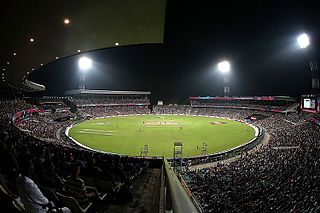
Cricket is a bat-and-ball game played between two teams of eleven players on a field at the centre of which is a 20-metre (22-yard) pitch with a wicket at each end, each comprising two bails balanced on three stumps. The batting side scores runs by striking the ball bowled at the wicket with the bat, while the bowling and fielding side tries to prevent this and dismiss each player. Means of dismissal include being bowled, when the ball hits the stumps and dislodges the bails, and by the fielding side catching the ball after it is hit by the bat, but before it hits the ground. When ten players have been dismissed, the innings ends and the teams swap roles. The game is adjudicated by two umpires, aided by a third umpire and match referee in international matches. They communicate with two off-field scorers who record the match's statistical information.
Off theory involves concentrating the line of the bowling attack just outside the off stump. This area is often referred to as the "corridor of uncertainty", as unless a batsman knows exactly where his off-stump is, he will have to play a shot at any ball bowled there. (Not to do so runs the risk that the ball will hit off-stump, which would not only get the batsman out but leave him looking extremely foolish.) The attack is supported with several fielders in a cordon of catching positions called slip fielders behind the wicket on the off side. The aim is to entice the batsman to play at the ball with the bat away from the body ('fishing outside off-stump'). This provides several ways in which the batsman can get out:

In cricket, the stumps are the three vertical posts that support the bails and form the wicket. Stumping or being stumped is a method of dismissing a batsman.
In the sport of cricket, the corridor of uncertainty is an area where a cricket ball can pitch during a delivery: a narrow line on and just outside a batsman's off stump. The name is derived from the opinion that this is the area in which a batsman struggles most to determine whether to play forward or back, or to leave the delivery. If a batsman leaves the ball, there is a chance the ball will turn inward and either bowl him or hit him with an increased chance of leg before wicket. If a batsman plays the ball, there's a chance the ball will go to the outside instead, leading to an outside edge that can be easily caught by the slip fielders or Wicketkeeper.
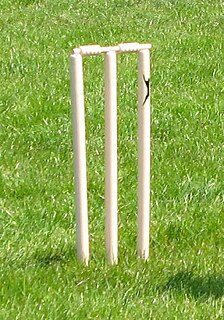
In cricket, the term wicket has several meanings. Firstly, it is one of the two sets of three stumps and two bails at either end of the pitch. The wicket is guarded by a batsman who, with his bat, attempts to prevent the ball from hitting the wicket.
- Edging the ball off the outside edge of the bat to the waiting catchers.
- Edging the ball off the inside edge of the bat into the wicket.
- Missing the ball and having it pass between the bat and the leg pads on to the wicket (being bowled "through the gate").
Originally developed in the late 19th century as an alternative to bowling directly at the wicket in an attempt to get batsmen out bowled or leg before wicket, off theory led to the rise in importance of slips and gully fielders as dedicated catching positions. The tactic has evolved until the modern day, in which the usual line of attack by fast bowlers is somewhat further outside off stump than it was typically in the 19th century.

Leg before wicket (lbw) is one of the ways in which a batter can be dismissed in the sport of cricket. Following an appeal by the fielding side, the umpire may rule a batter out lbw if the ball would have struck the wicket, but was instead intercepted by any part of the batter's body. The umpire's decision will depend on a number of criteria, including where the ball pitched, whether the ball hit in line with the wickets, and whether the batter was attempting to hit the ball.

In cricket, a slip fielder is placed behind the batsman on the off side of the field. They are placed with the aim of catching an edged ball which is beyond the wicket-keeper's reach. Many teams employ two or three slips. A floating slip is sometimes employed, usually in limited over games, who patrols an area in the slip cordon that would ordinarily be occupied by more than one fielder. The slip cordon's distance from the batsman increases with the pace of the bowler; generally they will be marginally further away from the batsman than the wicket-keeper is. Because of the resulting geometry, spin bowlers generally have fewer slips in the cordon than a fast bowler would in an equivalent game situation. As fielding in the slips requires quick reflexes and sure hands, usually the most adept catchers in the team will make up the slip cordon. Most slip fielders are top order batsmen. Specialist slip fielders are sometimes called "slippers".
Off theory - although not commonly known by that name now - has become the most common attacking bowling tactic used in cricket. It has thus developed many nuances and can be a ball-by-ball tactical struggle for supremacy between the bowler and batsman that many cricket fans find gripping when executed by a skilled bowler.



